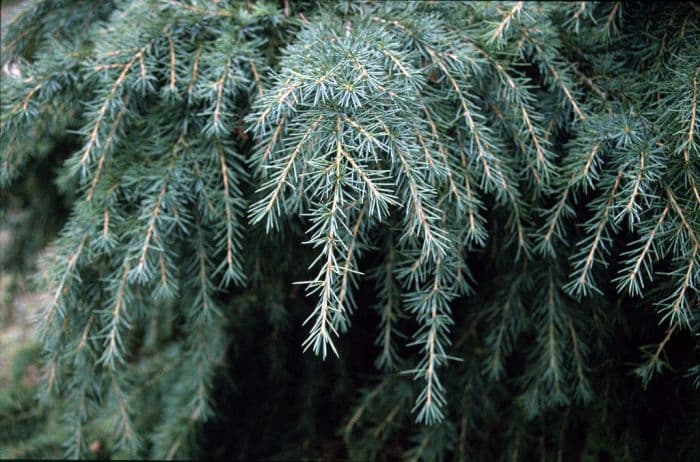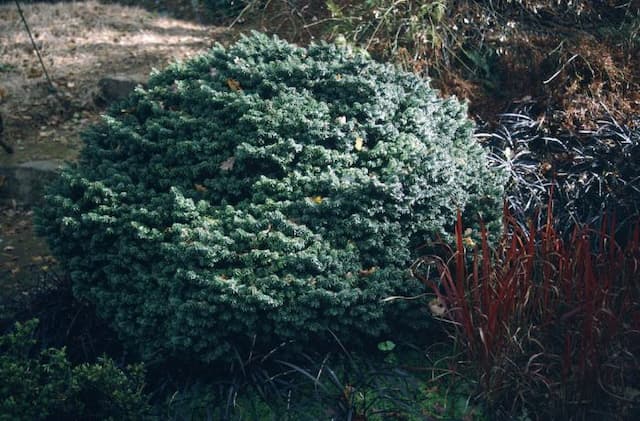Deodar 'Feelin' Blue' Cedrus deodara 'Feelin' Blue'

ABOUT
'Feelin' Blue' is a slow growing, almost prostrate conifer with bright blue-green foliage composed of soft, slender needles borne on arching branches
About this plant
 Names
NamesSynonyms
Deodar Cedar, Himalayan Cedar, Feelin' Blue Deodar Cedar.
Common names
Cedrus deodara 'Feelin' Blue'.
 Characteristics
CharacteristicsLife cycle
Perennials
Foliage type
Evergreen
Color of leaves
Blue-green
Height
4 feet (1.22 meters)
Spread
6 feet (1.83 meters)
Plant type
Tree
Hardiness zones
7
Native area
Himalayas
Benefits
 General Benefits
General Benefits- Compact Size: Ideal for small gardens or landscapes where space is limited.
- Ornamental Appeal: Offers unique silvery-blue foliage that adds year-round color interest.
- Low Maintenance: Once established, requires minimal care, making it a good choice for low-effort gardening.
- Drought Tolerance: Able to withstand periods of low water, which is beneficial in arid climates.
- Cold Hardy: Resilient in colder temperatures, which allows it to thrive in many climates.
- Attracts Wildlife: Provides habitat and nesting sites for birds, while also attracting beneficial insects.
- Erosion Control: Its root system helps to stabilize soil and prevent erosion on slopes and banks.
- Adaptable: Can thrive in a range of soil types, assuming they have good drainage.
- Long-Lived: Being a conifer, it is known for its longevity, adding permanence to the landscape.
- Minimal Pruning: Does not require frequent trimming, making it a low-maintenance option for busy gardeners.
 Medical Properties
Medical PropertiesThis plant is not used for medical purposes.
 Air-purifying Qualities
Air-purifying QualitiesThis plant is not specifically known for air purifying qualities.
 Other Uses
Other Uses- Bonsai Sculpting: Cedrus deodara 'Feelin' Blue' can be trained as a bonsai, particularly appealing for its unique blue-green foliage and compact growth habit.
- Garden Sculptures: The flexible and interesting branch patterns of 'Feelin' Blue' can be trained or pruned to create living sculptures in the garden.
- Privacy Screening: Despite its slower growth and smaller stature, 'Feelin' Blue' can be used in mass plantings to create a low, dense screen for privacy.
- Windbreaks: This plant can be positioned on properties to provide a windbreak, especially in gardens that require protection from harsh winds.
- Slope Stabilization: 'Feelin' Blue' cedar's root system can help stabilize slopes and control erosion in the landscape.
- Theme Gardens: Specific to gardens designed with a color theme, its blue-toned foliage can be a key element in 'blue' or 'cool-toned' gardens.
- Container Gardening: This dwarf cedar can add structure and color to container gardens, suitable for patios or terraces.
- Backdrop for Flowers: The blue foliage of 'Feelin' Blue' can serve as a contrasting backdrop, making the colors of flowering shrubs or perennials pop.
- Railway and Model Gardens: This dwarf cedar can be used in miniature landscapes, including model railway gardens, due to its scale and texture.
- Photography Prop: Professional and amateur photographers may use the textured foliage and unique form of the 'Feelin' Blue' as a prop or backdrop in garden photography.
Interesting Facts
 Feng Shui
Feng ShuiThe Deodar Cedar is not used in Feng Shui practice.
 Zodiac Sign Compitability
Zodiac Sign CompitabilityThe Deodar Cedar is not used in astrology practice.
 Plant Symbolism
Plant Symbolism- Immortality: Cedrus, or Cedar, often symbolizes immortality due to its evergreen nature and the longevity of the tree, implying endurance through time.
- Strength: Cedar trees are known for their strong wood, making them a symbol of strength and stability.
- Purity: The aromatic wood of the cedar is thought to purify and protect, hence it is associated with cleansing and protection.
- Healing: Traditionally, Cedar has been used in various cultures for medicinal purposes, symbolizing healing and health.
- Spirituality: Cedars are considered sacred in many traditions, representing spiritual growth and enlightenment.
- Peace: The calming scent and majestic presence of cedar trees are often related to tranquility and peace.
 Water
WaterDeodar Cedar, commonly known as 'Feelin' Blue', should be watered deeply but infrequently, allowing the soil to dry out partially between watering sessions. A general rule is to provide about 1 to 2 gallons every week for young plants, adjusting the amount for mature trees based on their size and the weather conditions. During the growing season in spring and summer, they might need water once or twice a week depending on rainfall. In the fall and winter, watering can often be reduced to every two to three weeks, especially if there is sufficient rain. It's essential to avoid overwatering as this can lead to root rot.
 Light
LightDeodar Cedar, also known as 'Feelin' Blue', thrives in full sun where it can receive at least six hours of direct sunlight daily. It's best positioned in a spot that is not shaded by buildings or larger trees for the majority of the day. Some light afternoon shade can be beneficial in extremely hot climates to prevent scorching of the foliage.
 Temperature
TemperatureThe Deodar Cedar or 'Feelin' Blue' performs well in a wide range of temperatures but prefers cooler climates. It can withstand a minimum temperature down to around -10°F and a maximum temperature well into the 90s°F. The ideal temperature range for optimal growth is between 40°F and 70°F. This cold-hardy conifer does not tolerate extremely hot conditions well.
 Pruning
PruningDeodar Cedar 'Feelin' Blue' may require pruning to shape the plant, control its size, or remove any damaged branches. Pruning should be done sparingly and is best performed in late winter or early spring before new growth starts. It's important not to prune too much at once since it can stress the plant. Generally, prune no more than once a year unless there is damage or disease that requires attention.
 Cleaning
CleaningNot needed
 Soil
SoilThe Deodar Cedar 'Feelin' Blue' thrives best in well-draining, acidic to neutral soil with a pH range of 6.0 to 8.0. A mix that includes organic material such as peat moss, composted pine bark, and either perlite or vermiculite to improve drainage would work well for this plant.
 Repotting
RepottingDeodar Cedar 'Feelin' Blue' is a slow-growing conifer and typically does not require frequent repotting. It may only need to be repotted every 3 to 5 years, depending on the growth rate and the size of the container.
 Humidity & Misting
Humidity & MistingDeodar Cedar 'Feelin' Blue' is adaptable to a wide range of humidity levels and does well in the average outdoor humidity. It does not have specific humidity requirements indoors but should not be subjected to extremely dry environments for prolonged periods.
 Suitable locations
Suitable locationsIndoor
Provide bright light; water sparingly.
Outdoor
Full sun, well-drained soil, space adequately.
Hardiness zone
7-9 USDA.
 Life cycle
Life cycleThe common name for Cedrus deodara 'Feelin' Blue' is the Deodar cedar. The life cycle of the 'Feelin' Blue' Deodar cedar begins with germination from a seed, typically taking several weeks, under suitable conditions of moisture and temperature. After germination, the seedling stage is characterized by the emergence of the first set of true cedar leaves, and the plant slowly begins to establish a root system. As it enters the juvenile stage, 'Feelin' Blue' exhibits more pronounced blue-green foliage and starts to develop its distinctive low, spreading form. In maturity, 'Feelin' Blue' reaches a stable size and shape, produces cones, and can live for many decades, even centuries, with peak reproductive output during its optimal years. Following the productive period, the tree may experience a decline phase due to old age or environmental stresses, eventually leading to its death.
 Propogation
PropogationPropogation time
Spring-Early Summer
The Cedrus deodara 'Feelin' Blue', commonly known as the Deodar Cedar, is typically propagated through semi-hardwood cuttings, which is the most popular method. The best time for taking cuttings is during the late summer when the current season's growth has begun to mature. To propagate, select a healthy branch and prepare a cutting that is about 4 to 6 inches (10 to 15 cm) long, making sure it includes at least two sets of needles. Dip the cut end into rooting hormone powder to encourage root development. Then, plant the cutting into a well-draining potting mix, ensuring the needles remain above the soil surface. Keep the soil moist but not waterlogged and place the cutting in a location with indirect light and moderate temperature. Root development typically takes several months, after which the cutting can be transplanted into a larger pot or directly into the garden.









